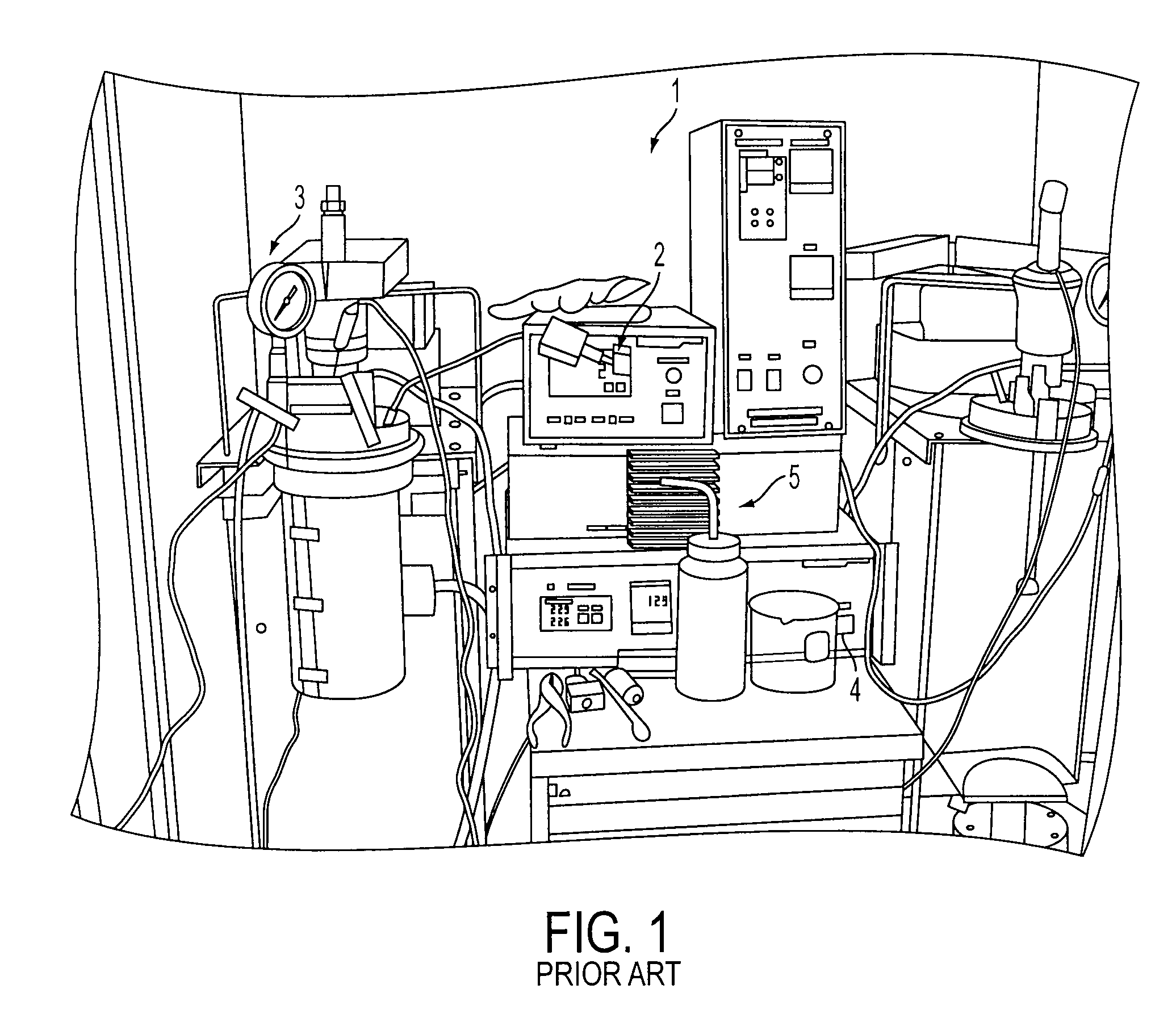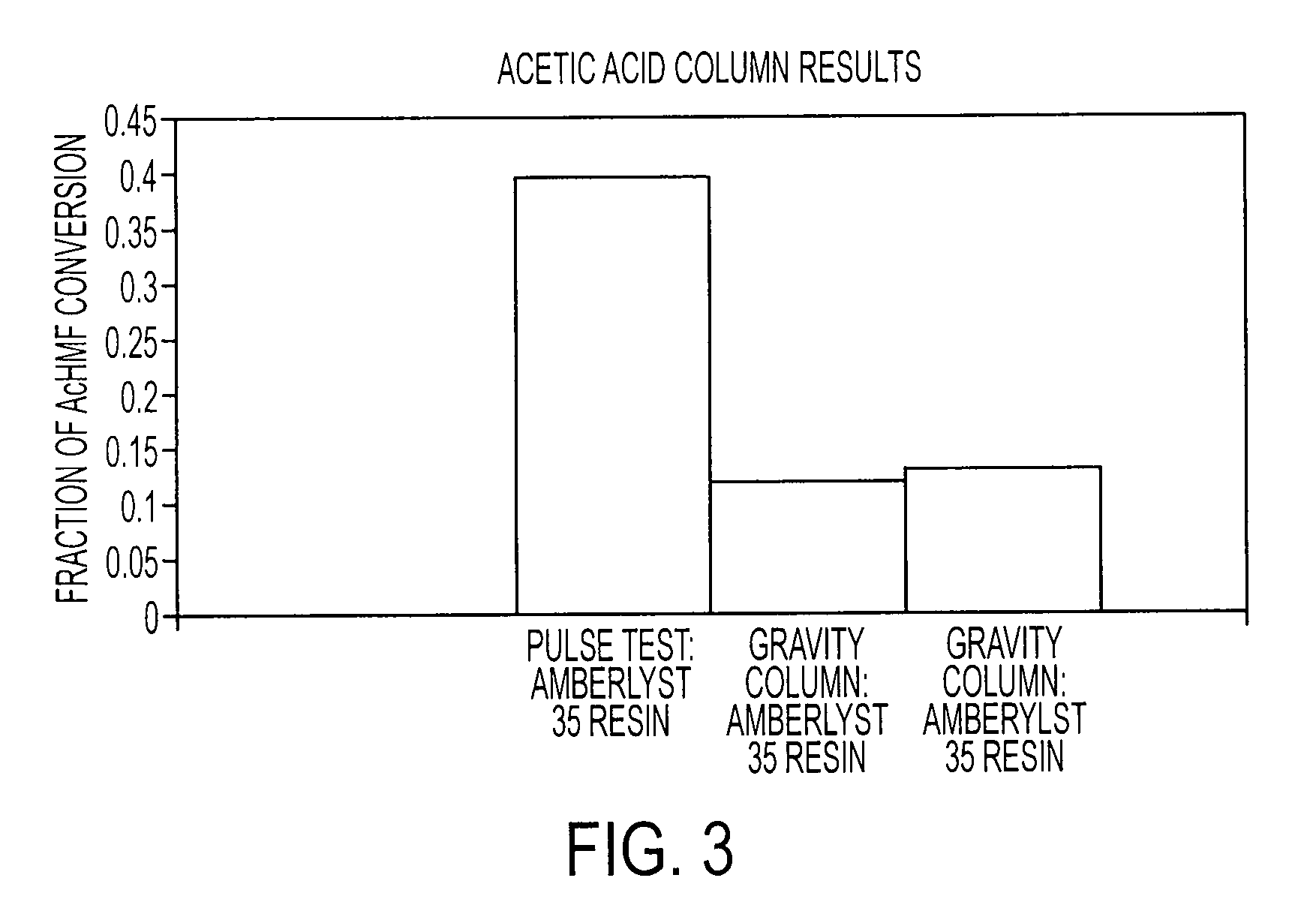Conversion of carbohydrates to hydroxymethylfurfural (HMF) and derivatives
a technology of hydroxymethylfurfural and conversion rate, which is applied in the preparation of carboxylic compounds, organic chemistry, chemistry apparatus and processes, etc., can solve the problems of plethora of unwanted side products, inability to find a method which provides hmf with good selectivity and high yield, and further complications, etc., to achieve stable hmf form, high conversion rate of carbohydrates, and lower cost of materials
- Summary
- Abstract
- Description
- Claims
- Application Information
AI Technical Summary
Benefits of technology
Problems solved by technology
Method used
Image
Examples
example 1
[0064]The conventional method for synthesizing HMF and AcHMF from fructose includes a batch reaction on an autoclave (Parr) reactor followed by a separate step for purification. As shown in FIG. 1, the temperature control 2 controls both the temperature of the reaction mixture and the heating jacket in the autoclave reactor 1. A heating jacket (not shown) is used to heat the reaction. The pressure gauge 3 shows if the reaction is creating gas, or monitors the pressure on the vessel if it was applied. The speed control 4 is for the stirring mechanism. Stirring is necessary to keep the reaction mixture in contact with all necessary materials. The sample port 5 allows the scientist to retrieve samples and specific points during the reaction to monitor for progress. Reactants must be in solution before being put into a reactor vessel.
[0065]The reaction conditions for the autoclave reactions were varied to test the effect of different reaction conditions. The reactions were performed in ...
example 2
[0070]The graph shown in FIG. 4 illustrates the results of the pulse resin test at 80° C. where the flow rate was set at about 1.48 mL / min. for the first 33 minutes and about 1.36 mL / min. after the 33rd minute until completion of the reaction at about 63 minutes. After approximately 30 minutes, 0.07 moles of AcHMF was eluted, compared to a mole fraction of approximately 0.0006 for the starting material, fructose. The byproducts, levulinic and formic acids, are also measured. No measurable levulinic acid was found during the synthesis of AcHMF.
TABLE 3TimeSamplePercent waterFraction of waterWeight of watermoles of water(min.)weight (g)in samplein samplein sample (g)in sample10.50602.280.02280.01153680.00064036490.51891.390.01390.007212710.00040035120.50591.440.01440.007284960.000404361150.49821.300.01300.00647660.000359492180.50711.260.01260.006389460.000354655210.50621.240.01240.006276880.000348406240.41221.400.01400.00577080.000320315270.47821.460.01460.006981720.000387529300.50511....
example 3
Preparation of HMF from Fructose Using a HMF Ester Intermediate
[0071]This example illustrates the use of the present methods to deprotect HMF ester to provide substantially pure HMF. The feed material was prepared and placed in a vial of methanol and Amberlyst A26OH resin obtained from Rohm and Haas Company (Woodridge, Ill.). Amberlyst A26OH resin is a strong base, type 1, anionic, macroreticular polymeric resin based on crosslinked styrene divinylbenzene copolymer containing quaternary ammonium groups. After sitting at room temperature for about 5 minutes, the material was analyzed by thin layer chromatography (tlc) to show deacylation. The solid yield was about 85% HMF with about 8% AcHMF determined by a Shimadzu QP-2010 GC Mass spectrometer. The chromatogram is shown in FIG. 5. The remaining material was residual methanol. Heating the methanol solution with a heat gun to 60° C. for less than 5 minutes converted the remaining AcHMF to HMF. Alternatively, passing the product throug...
PUM
| Property | Measurement | Unit |
|---|---|---|
| Temperature | aaaaa | aaaaa |
| Temperature | aaaaa | aaaaa |
| Temperature | aaaaa | aaaaa |
Abstract
Description
Claims
Application Information
 Login to View More
Login to View More - R&D
- Intellectual Property
- Life Sciences
- Materials
- Tech Scout
- Unparalleled Data Quality
- Higher Quality Content
- 60% Fewer Hallucinations
Browse by: Latest US Patents, China's latest patents, Technical Efficacy Thesaurus, Application Domain, Technology Topic, Popular Technical Reports.
© 2025 PatSnap. All rights reserved.Legal|Privacy policy|Modern Slavery Act Transparency Statement|Sitemap|About US| Contact US: help@patsnap.com



